Malta is actually composed of seven islets and the main island, most populated and where the international airport is also called Malta. Gozo Island is second-largest of the Maltese islands and means “joy” in Castilian. It makes for a wonderful day trip or stay from Malta. See how to spend a day in Gozo Island.
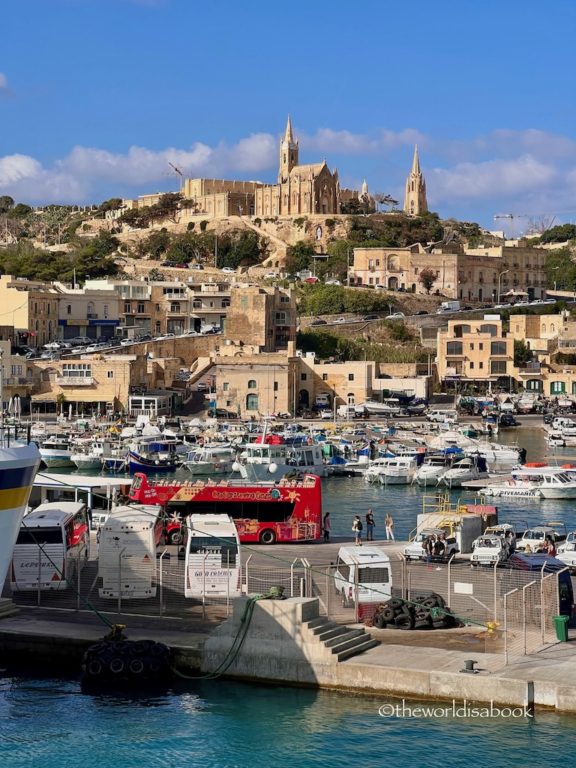
There are about 30,000 residents in Gozo occupying 26 square miles – 9.5 miles long and four miles wide. It’s easy enough to see many of its main attractions during a day trip.
It is also a bit more rural, quieter and much more slow-paced than Malta. Gozo Island is what Malta was before development and an influx of tourists happened.
Getting to Gozo
There are several options to get to/from Gozo from Malta depending on your budget and how you want to travel.
This seemed to be the most popular option and what we used to get to the island. The main Gozo Channel Line ferry has frequent service between the two islands and only a 25 – minute ride. It transports foot passengers and cars. In Malta, the ferry leaves from Ċirkewwa which is at the island’s northernmost area.

You can get to Ċirkewwa from many places around Malta via the local buses. Travel time from St. Julian’s (where many resorts are) for example was over an hour and about 1.5 hour from Sliema. You can also get there using Uber and another popular company on the island called Bolt offering rides.
Ferry Services
We booked a Gozo Island tour from our Westin Resort hotel in St. Julian’s which included transport to and from the Ċirkewwa ferry terminal. A van picked us up in the morning from our hotel and a large tourist bus dropped us on the way back. We were with other tourists who also got picked up in nearby hotels.
if you’re staying in or near Valetta, there are two fast ferry services ( Gozo Fast Ferries and Virtu Gozo Ferries) that will take about 45 minutes to Gozo. Though, these are smaller passenger ferries compared to the Gozo Channel ferries so the trip can be rough and likely to get cancelled if the weather is bad.
iSeeMalta is a company that also offers the Gozo Pass tour that includes the ferry ride and then the Hop-On/Hop-Off bus tour in Gozo. The ferry stops in Sliema, St. Julian’s and Buġibba/Qawra/St. Paul’s Bay.
The Malta-Gozo Ferry Ride
The Gozo Channel communal ferry was a quick 25-minutes to cross. It was very organized and spacious. The ferry had plenty of restrooms, indoor and outdoor seating, a cafeteria, and a convenience market. We enjoyed standing outside and watching the crew pull up the anchor and passing by Camino Island.
Many of the tours from Malta on a day trip to Gozo usually include the crossing costs whether on their smaller boats or provide ferry tickets using the Gozo Channel Line Ferry. We used a tour company called Yippee and they have their own boats exclusively for their guests if the weather is good and it’s not too windy.
During the summer, these boats also stop at the Blue Lagoon in Comino (a neighboring island) and caves and a swim at Crystal Lagoon. We were here in early November and it was a bit windy so we ended up riding the regular big ferry with no stops in Comino.
We arrived in Gozo’s Mgarr harbor which looked so idyllic as we were docking. The harbor was small with a prominent church and other buildings on the hilltop. We highly recommend going out on the deck as you pull in and out of the harbor .

Gozo Tour Options
Once you’re in Gozo, you have several options to see the island’s attractions. It was a short walk out of the marina to a parking lot where the tour buses and tour guides and vehicles waited for boarding. There were plenty of signs and the tour guides were quite visible so it was hard to get lost after getting off the ferry.
Tuk tuk tour
This was our tour during our visit to Gozo. Each tuk tuk holds six people plus the driver. The tuk-tuks were driven by multi-lingual drivers/guides and the tourists were divided by languages spoken.
Our tuk-tuk was driven by an Englishman who has lived in Malta for over 20 years and we were with an Irish couple and two Dutch young men. This was not a commentary tour since it was hard to hear our tuk tuk driver and he didn’t really gave much information at each stop. But, he was very informative once we started asking questions.
The good thing about this tour was we were able to go on narrow alleys and roads that the HOHO buses could not. It was actually not as bumpy as I thought it would be.

EJeep Safari
This is a self drive option for four people that enables a DIY option to tour the island with the help of navigation software. We most likely would have done this tour if our kids were with us.
Go Car Tours
This two-seater with only three wheels as a self-drive option looked fun at first glance. But, they followed us and were actually part of our tour. The only difference was they were driving themselves. The tourists, who were with us said it was quite bumpy and slow.

ATV tours
For a more bumpy and adventurous ride, the all-terrain vehicles or ATVs were another option. They were also part of a tour and followed a tour guide.
Hop-on/Hop-Off (HOHO) tour
This Hop-on/Hop-Off open-top, double decker bus meets tourists on the Mgarr Harbour for a tour. The two-hour bus route has two lines (purple and blue) that tourists can switch between. This route has 14 stops allowing visitors to hop on and hop off and stay at each stop as long as they want at the main attractions. Headphones are provided to listen to commentary, available in eight languages, as you stop at each attraction.
I like this option for convenience but there are some places in Gozo where the buses couldn’t fit which is where the other options like the tuk tuk, go car and ATV came in. There is also a combo pass with the hop-on-hop-off bus and ferry.
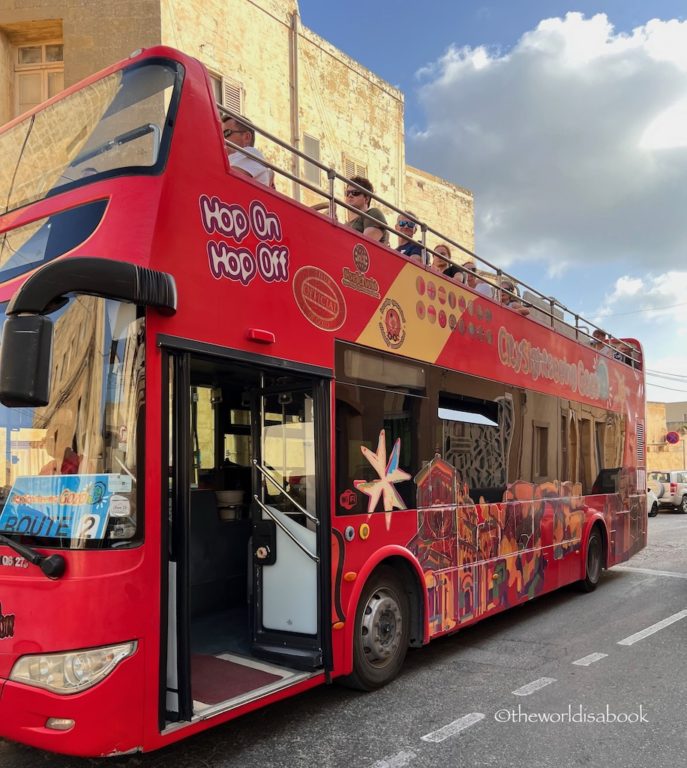
Rent a car
If you rented a car in Malta and brought it over via the ferry, it is much more convenient and will give you more time to explore and see the island’s attractions. Gozo is a bit more laid back and not as intimidating with traffic compared to Malta. My husband was very hesitant driving in Malta but would not have had issues driving in Gozo.
Visitors can rent a car after getting to Gozo too. A quick Google search shows several agencies or use your favorite and reputable travel consolidator agency.
Many seem to either deliver and pick up at the ferry terminal or pick you up to take their office. I would definitely consider this option on our return trip to Gozo.
Things to see and do in Gozo Island
These are the main attractions that we stopped on our tuk-tuk tour and the highlights of our trip on the island.
Ta’ Pinu National Shrine
Our first stop was the Shrine of the Blessed Virgin of Ta’ Pinu which is a Catholic basilica. This was a beautiful church. There were several sets of religious mosaics outside and they were amazing. The details and colors were so beautiful.
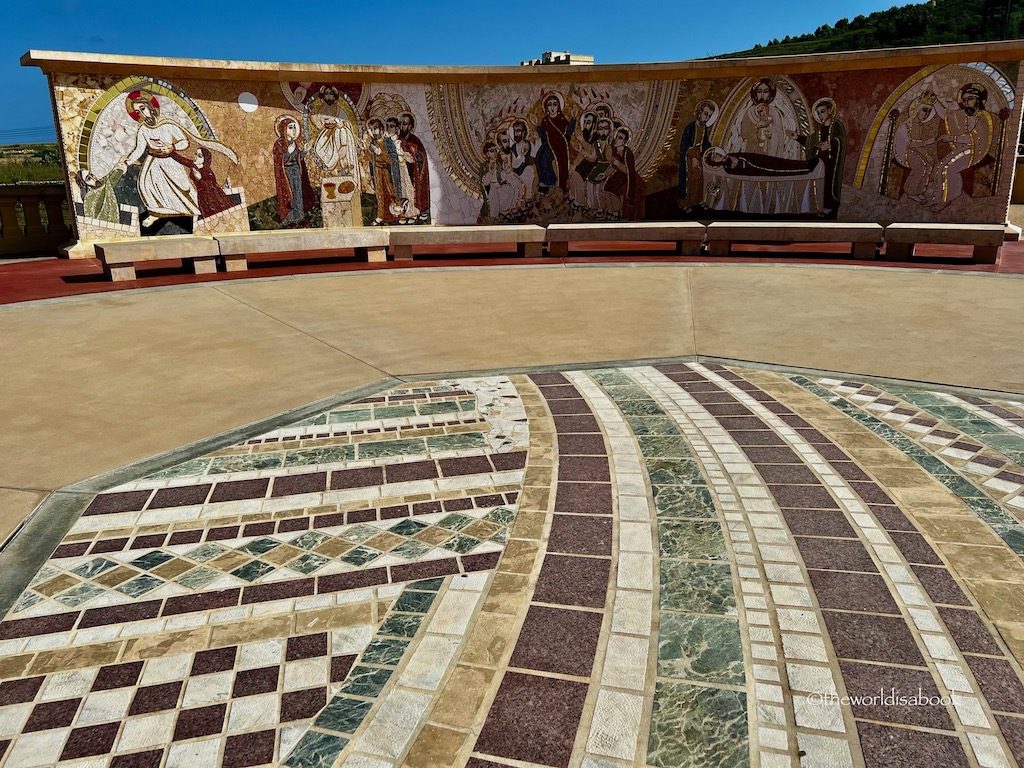
History and legend intertwine in this church’s history. People knew a chapel, once called the Tal– Ġentili, dedicated to the Assumption of Mary, had stood here before the 16th century.
In the late 1500s, Filippo “Pinu” Gauci bought and restored the chapel, and they changed its name to Ta’ Pinu in his honor, meaning “of Philip”. Gauci also commissioned an oil painting of the Assumption of Our Lady or Madonna Ta’Pinu, used on the main altar, which was completed in 1619.

This church has become known as the “church of miracles” after the Blessed Mother Mary appeared to a woman farmhand to pray in the chapel in 1883. Several miraculous healings started happening around the area too after. The chapel became a site for pilgrimages and made it necessary to build a bigger church.
They finished the current neo-Romanesque National Shrine in 1931 in front of the site where the old chapel used to be. This church interior was also quite impressive.
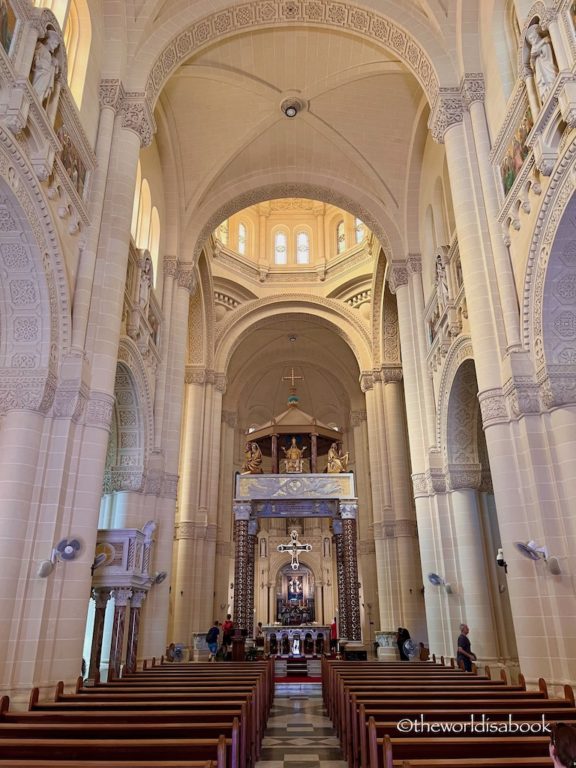
Xwejni Salt Pans
We passed by the Xwejni Salt Pans and quickly stopped for some photos. The locals have been making salt for generations in these pans by the ocean, which were cut out of the rocks. Salt-harvesting via evaporation has been a part of Gozo for many centuries dating back to the Roman times.
It was quite a sight to see so many of what looked like small square pools in one area spanning several miles in the northern coast.

Since we were only here for a short time and our guide didn’t really give us much information, I found some interesting information. Three families currently run the salt farms.
Salt-harvesting season starts in April. They collect salt twice a week until August. The farmers start their day at 4:00 AM (to beat the heat) and usually end at 8:00 PM. It is an arduous process of gathering and packaging the salt to sell.
We found artisan salt for sale in a couple of stores in Gozo. They make for great souvenirs.

Lunch at Qbajjar
We then headed to Marsalforn Bay to have lunch at Mellos Bar and Grill which was across from the water. Our tour included a light traditional lunch in their outdoor seating area and it was delicious.
The Gozitan lunch included a variety of pickled vegetables on bruschetta, a flaky pastry that was like a small pizza with vegetable toppings and a sweet dessert called halva or Helwa tat-tork (Turk’s sweet) made of nuts and vanilla plus wine or water.
There were only a couple of stores open near the restaurants but the bay was a beautiful place for a short pleasant walk after lunch.

The Citadel, Victoria
The Citadel is hard to miss as it looms over Gozo. Located high on a promontory, this ancient fortified city in Victoria (Gozo’s capital) was very impressive. It is on the tentative list for the UNESCO World Heritage Status. Our tuk tuk driver only gave us about 90 minutes to explore the fortress. From the main square in Victoria, it was a short walk uphill to the citadel grounds.
History of Gozo
People believed the citadel had been occupied since pre-historic times and has such a vast, rich history. Archaeologists believe it was fortified around 1500 BC. Several civilizations, including the Phoenicians and Romans who built temples and buildings here, invaded and occupied Malta.
Most of the citadel ruins seen today is from the late medieval period. They built a fortress on top of the Roman ruins to house and protect Gozo residents (Gozitans) from invaders during frequent invasions of the island. The fortification walls were pretty tall and made of gold-colored limestone.
It was a functioning fortified city where many families lived. Though, only a couple of families call the citadel home today. Most of the structures as well as the fortification walls have been well-preserved or restored carefully. The citadel is a complex of buildings with wonderful architecture, some military remnants and so full of history.
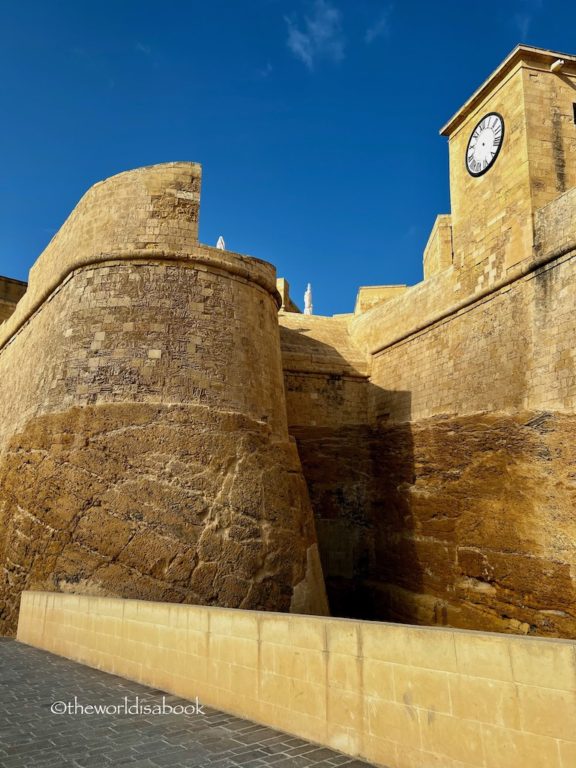
Visitor’s Center
The visitor’s center is a great stop before entering the citadel for an orientation. It was located outside the walls and housed in two old water reservoirs from the 1870s.
The center has interactive touch screens and exhibit panels on the citadel’s military and civil history available in eight languages. It also has a surround sound theater to watch a nine-minute video more on the citadel’s history.
It is open everyday except for Christmas and New Year’s Eve, Christmas Day and New Year’s Day. Though, the citadel is open all year everyday and 24 hours a day.
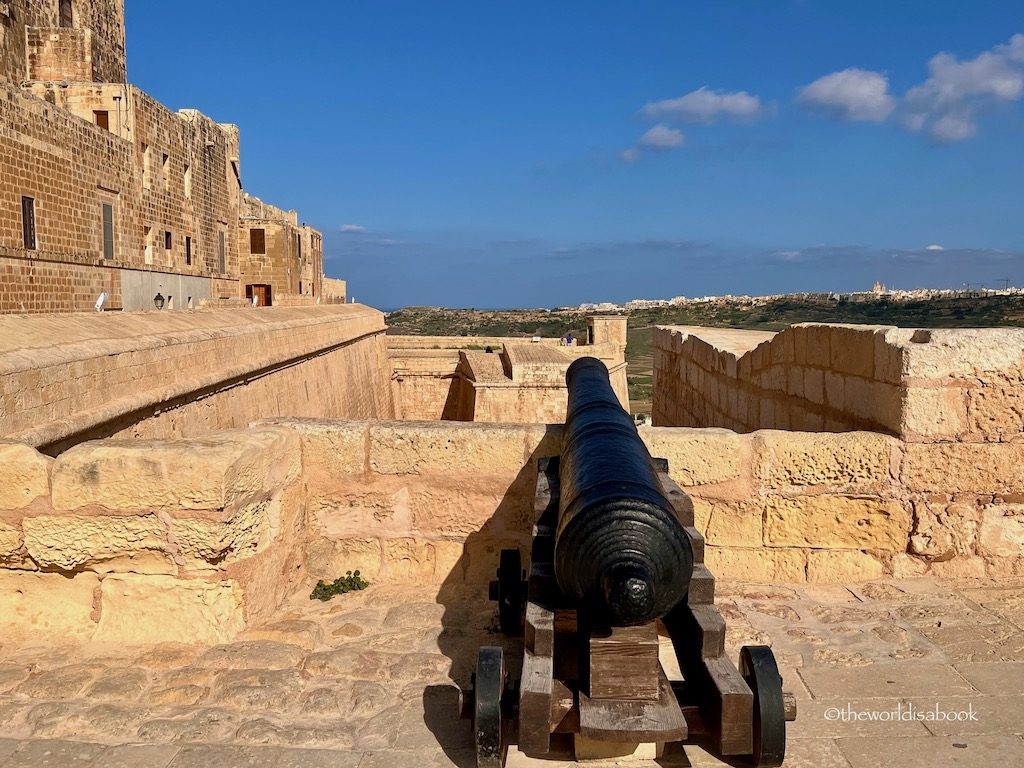
The visitor’s center isn’t free. An adult ticket cost €5.00. Students and senior tickets cost €3.50, while children (6-11 years) tickets cost €2.50. Children under the age of 6 years enter for free. These prices are as of December 2022.
This ticket also includes admission to the Gozo Archaeology Museum, the Nature Museum, the Old Prisons and the Gran Castello Historic House. I really wish we had visited these attractions since they looked so interesting and informative.
Museums and Church
While it is free to enter the citadel, some special areas like the cathedral and its museum require separate tickets.
We didn’t have enough time for museum visits or to really explore the visitor’s center and cathedral. But, if you’re here on a non-tour with more time, the museums offer interesting insights into Malta and Gozo’s history.
Don’t miss stopping and admiring the small scale model of the citadel outside of the visitor’s center. It gives an interesting perspective of the size of the citadel.
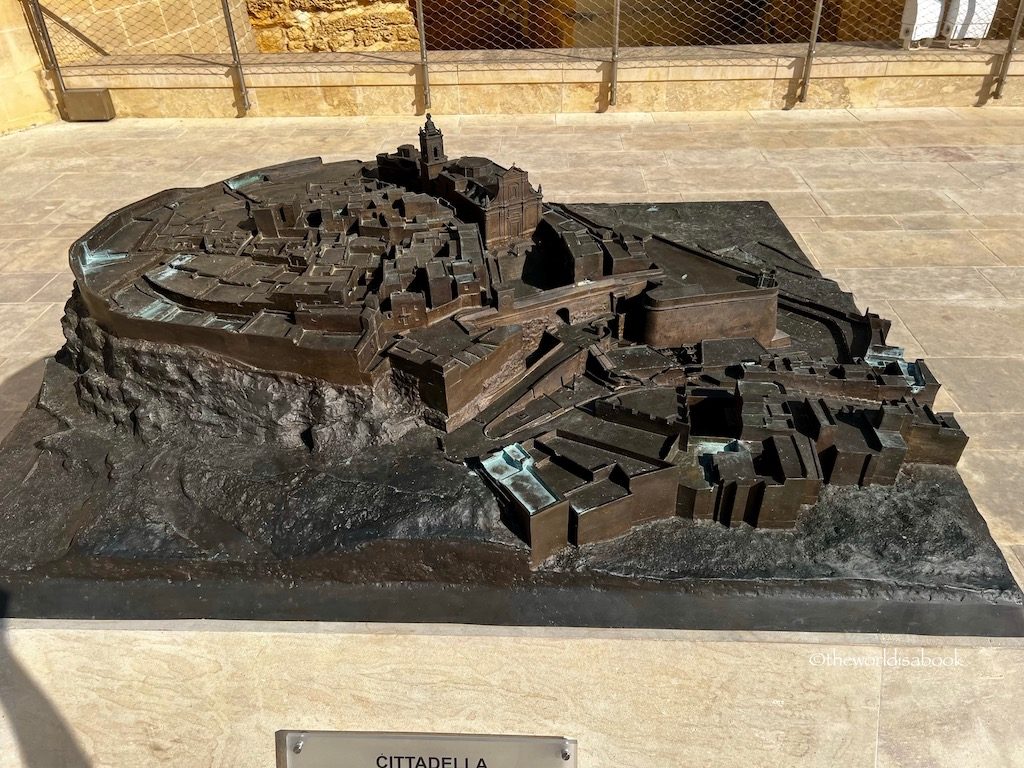
The imposing Roman Catholic cathedral greeted us at the entrance of the citadel. The baroque church was completed in 1711 by Maltese architect, Lorenzo Gafa, and dedicated to the Assumption of Our Lady or Santa Marija in Maltese.
This was once the site of a Roman temple dedicated to the goddess Juno. There was a statue here to honor Pope John Paul II who became the first pope to officially visit Gozo in 1990.
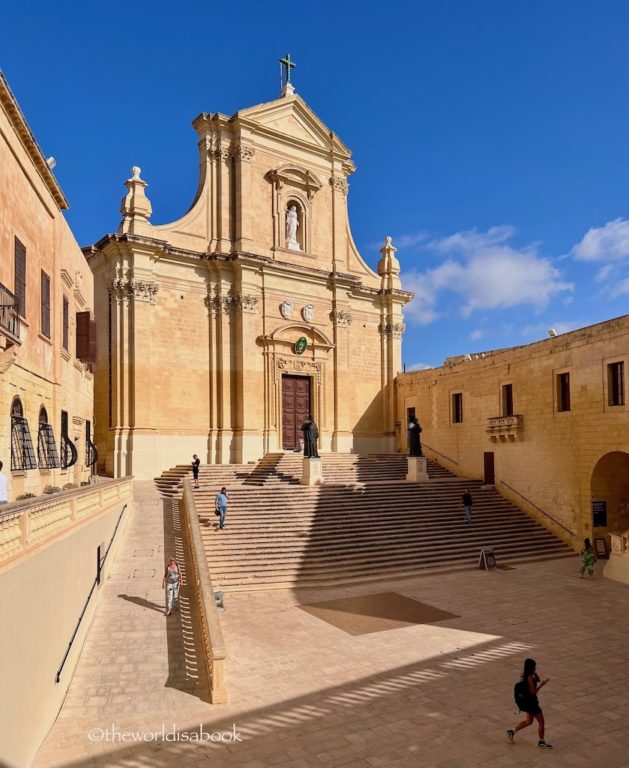
We recommend just walking around and exploring the narrow streets of the citadel. There were a few arts and craft stores, grain silos and even a World War II shelter. Since it was a military fort as well, there were large bastions and cannons to see too.
We enjoyed walking the charming of this small ancient fortified city. It truly felt like we stepped back in time. The back area of the citadel had some grassy parts and remnants of old structures.
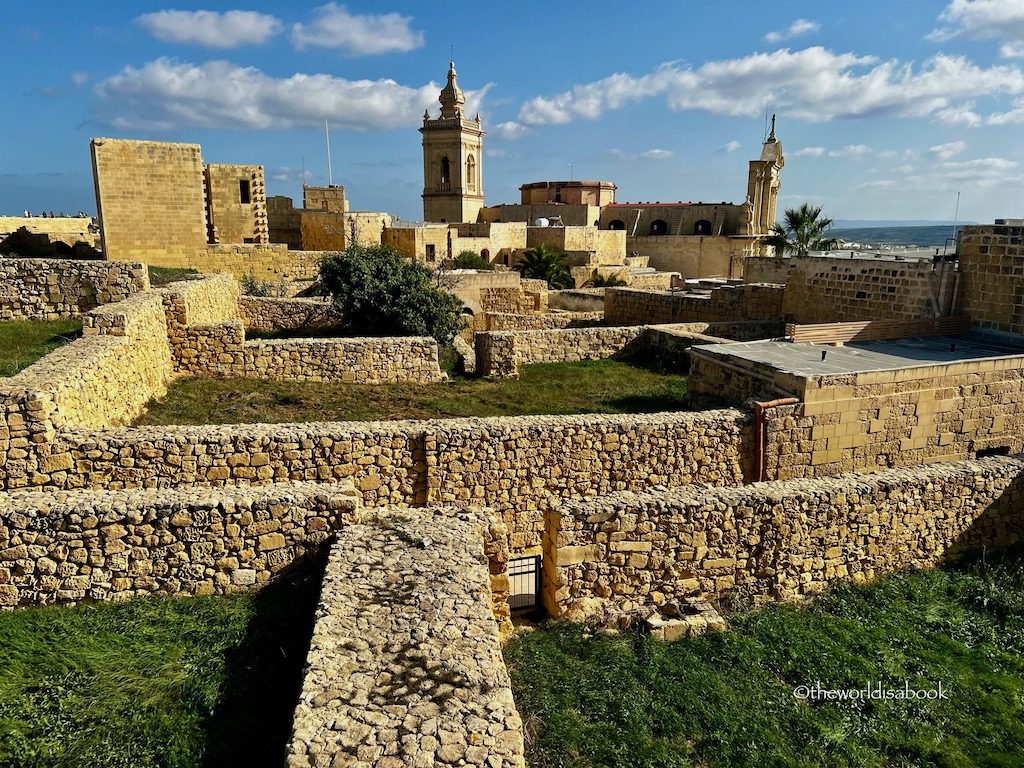
The Views
One of the best things about the citadel and its prime location are the panoramic views. We enjoyed walking the walls and stopping at several lookout spots that gazed out into Gozo’s countryside.
It was great to see the field terraces ready for planting and the landscape that extend out to the sea. I’m sure this looks even more spectacular during Spring with the wildflowers.
There was also a wonderful vantage point to see all of Victoria below. At the citadel’s highest point, it almost felt like we could see all of the island below and beyond.

Knight’s Wash houses – Fontana
Our tour also stopped at a public washhouse in the village of Fontana. There were two across from each other and we only went to one of them. In the 16th century, the Knights of St. John built these wash-houses on a side of a cliff around a natural spring.
The arched structure still had water running with a row of stone sinks on both sides and a stone bench/table in between. It provided shelter for people and cattle as well as washing clothes and where some locals still go for washing.
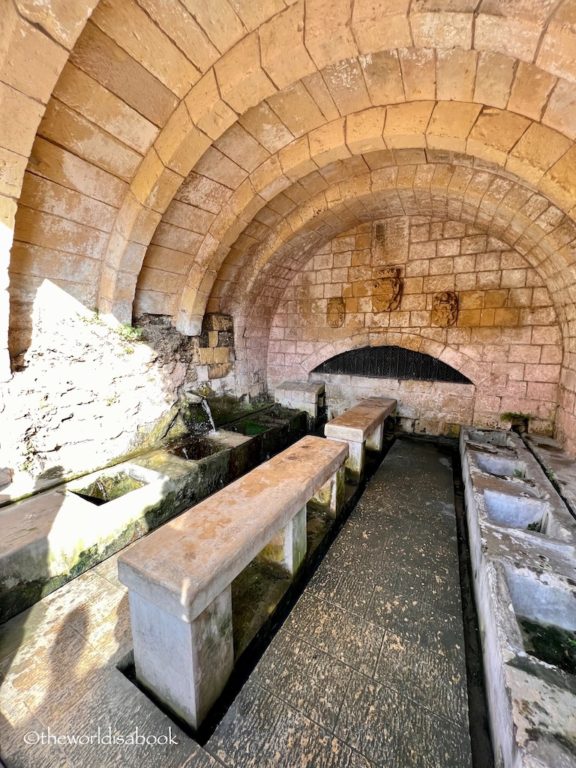
Across the street from the wash houses was Fontana cottage which was touted as the only traditional market in Gozo. This indoor market was a convenient stop since we didn’t have as much time to shop for souvenirs at the stores in Victoria.
This market had many arts and crafts including what Malta is famous for like handmade lace items. They also had quite a bit of food items. Try the prickly pear jam (made from the prickly pear cacti you see all over Gozo) and the nougats. They provided samples and you won’t regret buying them as souvenirs.

Sanap Cliffs
One of our favorite stops was a panoramic lookout and a popular sunset spot. The Sanap Cliffs (also called Ta’ Saguna Cliffs) are not easily accessible by public buses or the hop-on/hop-off bus tours since the roads were quite narrow. It was a great way for anyone on a tuk/tuk, ATV or segway tour to stop though.
The coastal area, located in the southern part of Gozo, was beautiful. Though, the short ride to get there from the village can be a bit nerve wracking for anyone with a fear of heights. There were only short stone borders with a cliff drop on one side of the road.

Panoramics Views of Sanap Cliffs
This area’s panoramic views were incredible. It was easy to see why people come here to watch the sunset including views of Malta and the neighboring island of Comino. The white, jagged limestone cliffs were amazing and this coastal view reminded us a bit of the Cliffs of Moher in Ireland.
If you’re in Gozo with a rental car, we highly recommend this stop. There was a small parking lot right after going through the village. The coastal walk here is also breathtaking. Bring a picnic and enjoy the views.

Our last stop on our tuk tuk tour was at Ta’Kenuna Tower. This was built in 1848 by the British and used as a semaphore tower to transmit signals.
It was restored in recent times and now being used as a telecommunications tower. The views of some of the rural and terraced land of Gozo from here was beautiful.

There was a small botanic garden below it showing some plants and flowers found around the islands with some signage for information. It also contained some indigenous and endemic plants like the Maltese Rock Centaury which is the country’s national plant.
We really enjoyed our day trip to Gozo Island. It was interesting to see the contrasts with Malta island. We liked the more laidback, relax lifestyle of Gozo and its more rural landscape yet it also had so much history and beautiful attractions.
I would love to stay in Gozo for a couple of nights when we return to Malta. There were more attractions we’d love to see like UNESCO World Heritage Ġgantija temples and archaeological park. But, this tuk tuk tour gave us a wonderful glimpse of Gozo.

Tips for Visiting Gozo Island
- The one day tuk tuk tour we did was seven hours plus transport to and from the ferry terminal. It makes for a very long but eventful day.
- Bring cash to tip your driver. They also collected payment (preferable cash) during lunch.
- Wear comfortable shoes. You will still be doing some walking especially at the citadel despite being driven around.
- Bring hair ties and layer up. In case you’re visiting during the non-summer season, it was quite windy at the citadel and the cliffs. Many of my photos had hair all over my face.
- Bring snacks and water for the ride. Other than lunch, there’s not much time to stop anywhere that readily had food and drinks.
Book your Gozo Island Tours from Get Your Guide below:
Pin it for later!
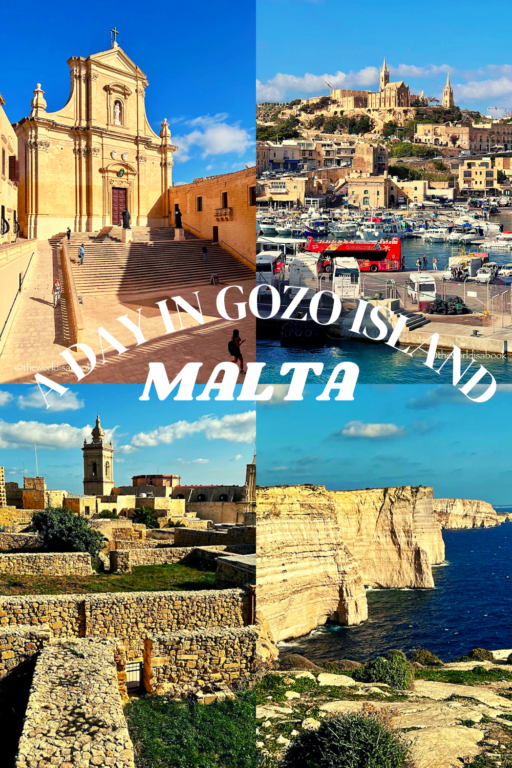
Very informative! I’ve been on a day trip to Gozo and didn’t get to visit everything you did. However we did see the Ggantija Temples and archeological park. We were on a larger tour bus and when visiting the wash houses and Fontana Cottage the roads were very skinny and we almost didn’t get through them. It was a wet and windy day, but I loved every bit of it. I wished the Azure Window natural arch was still in tact, but it had collapsed earlier that year. Thought at the time I would have liked at least one night on the island to see a bit more.